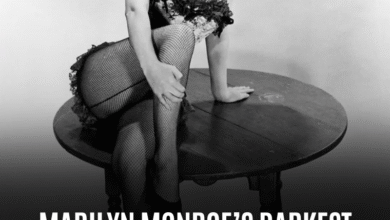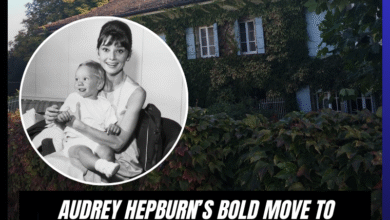Audrey Hepburn’s ‘Sabrina’ Drama: The Off-Screen Chaos That Nearly Ruined the Classic!
OPINION: This article may contain commentary which reflects the author's opinion.
Audrey Hepburn is a name synonymous with grace, elegance, and timeless charm, both on and off the screen. In her four-decade career, she rarely caused a stir in Hollywood and maintained good relations with nearly everyone she worked with. However, one of her most iconic roles—Sabrina (1954)—was overshadowed by behind-the-scenes drama that left tension in its wake. While the love triangle between Hepburn’s Sabrina and the two wealthy brothers, played by Cary Grant and Humphrey Bogart, was central to the plot, it was the off-screen turmoil between the cast and director Billy Wilder that truly stole the spotlight.
Casting Struggles and the Unlikely Casting of Bogart
When Billy Wilder set out to adapt the hit play Sabrina into a movie, he had a clear vision for his leads. Audrey Hepburn was an obvious choice for the title role, having just won an Oscar for Roman Holiday the previous year. For the two brothers, Wilder had initially envisioned Cary Grant as Linus, the serious, business-minded older brother, and William Holden as David, the charming, carefree younger sibling.
However, Grant famously turned down the role of Linus for reasons that remain unclear, and Wilder turned to the unexpected choice of Humphrey Bogart, known for his iconic roles in film noirs and dramas rather than romantic comedies. Bogart’s casting proved to be a mismatch—while Grant would have seamlessly embodied the role with his charm and wit, Bogart struggled with the comedic aspects of the role, which led to palpable tension on set. This miscasting would lay the groundwork for the chaos to come.
Bogart’s Grumpy Mood and On-Set Tensions
Humphrey Bogart’s notoriously difficult attitude on set created one of the film’s most significant hurdles. As much as his character Linus was a miserly figure, Bogart’s on-set behavior mirrored that personality. He resented Wilder’s decision to cast him in a comedic role, especially since the director had initially wanted Grant. His discomfort with the role led him to openly berate Wilder’s script rewrites, even claiming that his five-year-old daughter could write a better script. In addition, Bogart was frustrated with Audrey Hepburn’s supposed need for multiple takes—a contrast to his own more efficient method of working. But perhaps the most personal issue came from his longstanding animosity toward William Holden, who had starred in several of Wilder’s recent successes, including Sunset Boulevard and Stalag 17. Bogart’s insecurity grew as he suspected Wilder favored Holden over him, and this resentment seeped into the production, adding to the overall tension on set.
William Holden’s Affair with Audrey Hepburn
While Bogart’s frustrations were rooted in his insecurities, William Holden’s issues were of a different nature. When Holden first met Audrey Hepburn, he was immediately smitten with her, and the two likely had an affair during the shoot. This off-screen romance complicated their professional relationship, and Holden never fully got over his infatuation with Hepburn, admitting as much for the rest of his life.
But it wasn’t just the emotional turmoil that created complications—Holden’s busy schedule also contributed to one of the film’s major production headaches. He was committed to shooting The Bridges at Toko-Ri, a WWII film, and had to leave before Sabrina’s climactic scene could be filmed. This left director Billy Wilder in a bind, unsure of how to resolve the story’s ending. Wilder spent much of the production unsure if Sabrina would end up with David or Linus. Holden’s early departure forced him to rewrite the script, ultimately sidelining Holden’s character, David, and leaving Sabrina with Linus as her eventual choice.
Audrey Hepburn’s Steady Grace Amid the Chaos
Despite the constant tensions surrounding the production, Audrey Hepburn remained a calm and professional presence. She kept her personal life separate from the set and was praised for her grace under pressure. As the center of the love triangle, Hepburn’s portrayal of Sabrina was undeniably charming, and her ability to navigate the chaos surrounding her only added to her on-screen allure. Hepburn was able to keep the film’s tone light and engaging, even as behind-the-scenes turmoil threatened to overshadow the project. Her calm demeanor was the glue that held Sabrina together, ensuring its eventual success.
The Legacy of Sabrina
Despite its behind-the-scenes challenges, Sabrina has endured as a beloved classic, largely due to Hepburn’s magnetic performance and the eventual resolution of its production issues. The film has aged gracefully, with Hepburn’s charm and wit still shining through the film’s romantic comedy plot. The on-screen love triangle between Sabrina, Linus, and David may have been central to the plot, but it was the behind-the-scenes drama between the three leads that truly gave the film its lasting intrigue.
Today, Sabrina remains a quintessential example of classic Hollywood filmmaking—complete with its fair share of off-screen drama, but ultimately defined by Audrey Hepburn’s impeccable presence and the chemistry between its cast. It’s a testament to how even the most chaotic productions can lead to cinematic magic, provided the right elements align.



